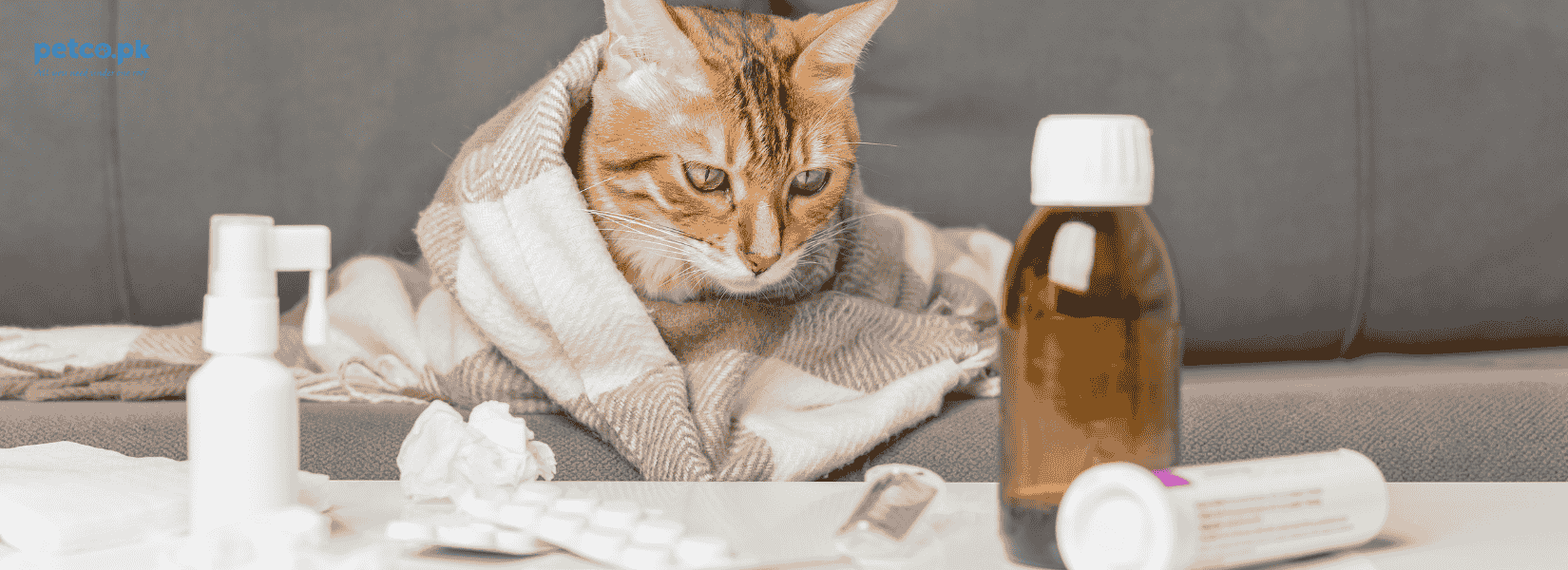
Protect Your Cat from Autumn Allergies with the Right Diet
Autumn is a time of great beauty and cool days. But it can also be a difficult time for your cat when allergies flare up. From falling leaves to rising molds and pollen, all of these environmental changes can compromise your furry friend’s health. Your veterinarian may prescribe medications to manage your cat’s allergies better. Your cat’s diet can potentially help reduce allergy symptoms and strengthen the immune system. Feeding your cat the right nutrients can help reduce inflammation and itching, while also promoting digestion and skin health. Therefore, in this article, we will share some ideas on how to ensure your cat is well protected at this time of the year by feeding her appropriately.
Like people, cats can also experience seasonal allergies when autumn arrives. There are a number of allergens that trigger your cat’s allergy season, including airborne pollen from late blooming weeds, mold spores from decaying leaves, dust mites, and also the indoor irritants due to more time spent indoors at the end of summer. Symptoms to look for in cats include sneezing, scratching or itching, watery eyes, or even inflamed skin. A veterinarian can identify allergies, and more often than not, relief can be obtained through medication. However, long-term holistic improvement would include dietary changes to decrease inflammation and somewhat improve immune defense against allergens naturally.
Common Symptoms of Seasonal Allergies in Cats
Cats with allergies to the fall season can display subtle or not-so-subtle symptoms. Common symptoms include excess grooming, scratching, skin rashes, sneezing, coughing, or watery eyes. Gastrointestinal symptoms such as vomiting or diarrhea can also be symptoms of allergy. Allergic reactions could be a cause for loss of fur and hot spots. Still, a pattern of symptoms that occur consistently at the same time every year could provide evidence that your cat has allergies. Self-monitor and observe your reactions when observing cat behaviour, which helps you identify the reaction and find relief before the symptoms worsen.
How Diet Affects Allergies in Cats
Nutrition impacts how your cat manages and recovers from allergies. A complete and balanced diet will help reduce inflammation, improve irritated skin, and ensure a healthy immune response. Allergic flare-ups in cats can occur for a variety of reasons, such as a food sensitivity or a depressed gut flora on top of weak immunity. Feeding an anti-inflammatory, protein-rich, natural/new diet will minimize the risk of allergies in the first place. Including omega-3 fatty acids, antioxidants, and limited-ingredient formulas can aid in relieving the allergic response and promoting resilience to seasonal allergens.
The Role of Protein in Allergen Management
High-quality animal protein serves as the basis of a healthy feline diet. The protein will help repair damaged tissue and provide immune support, which is especially important during allergy season. Unfortunately, some cats can be allergic to the more common proteins such as chicken or beef. A practical way to avoid reactions is to switch to a novel protein and feed a single-protein-source diet, such as duck, rabbit, or venison. Feeding a single protein formula will also help you identify any sensitivities that your cat may have. Feeding your cat a diet with adequate protein tailored to their unique needs can help minimize inflammation and support overall allergic recovery.
Omega-3 Fatty Acids: Natural Anti-Inflammatory
Omega-3 fatty acids are a great tool to add to your arsenal in allergy management. Omega-3s are found in fish oil, krill oil, and flaxseed. Omega-3s provide protection against the effects of inflammation, soothe dry or itchy skin, and provide immune support. Omega-3 fatty acids are known to promote a healthy, full, shiny coat and joint health.During allergy season, an increase of omega-3 fatty acids can help reduce inflammation that causes irritation and discomfort. Consider asking your veterinarian if fish oil is an appropriate addition to your cat’s diet or looking for a food blend that is rich in omega-3s to provide additional help against allergies.
Choosing Grain-Free or Limited Ingredient Diets
Many cats are sensitive to grains like corn, wheat, or soy, which can trigger or exacerbate allergy symptoms. Grain-free diets eliminate the most common irritants and help with digestion and skin health. Limited ingredient diets (LID) take this further by providing as few ingredients as possible to help you find and eliminate any allergens. They help limit exposure to possible triggers, making them suitable for cats with food allergies or food intolerances. You should always consult with your veterinarian before switching your cat’s food to make sure its nutritional needs are met.
Hypoallergenic Cat Food Options for Allergy Relief
Hypoallergenic cat food is designed for cats at risk of developing allergies. The diets available are usually hydrolyzed protein diets, which are proteins that have been broken down into smaller pieces so the immune system doesn’t recognize them as an allergen. Most prescription diets are used for allergies that are more severe in nature. Some over-the-counter diets to consider contain unique proteins and very few fillers. Hypoallergenic diets are ideal to be fed right now as we move into allergy season and preferably some time before fall to give your cat a fresh nutritional slate, and to limit your cat’s immune system’s exposure to common dietary triggers.
Avoid Artificial Additives and Fillers
Artificial colors, preservatives, and flavorings can exacerbate allergies in sensitive cats. Artificial ingredients may irritate the digestive system, causing some degree of inflammatory reaction. A good rule of thumb is to always look for natural cat food brands that do not contain any artificial ingredients, and are made from whole food ingredients that offer good nutritional content. Feeders, such as by-products of fish, chicken, or turkey, provide no nutritional value and are essentially fillers that may also contain allergens. Clean food labels will aid in reducing the allergy load on your cat’s system by contributing to the long-term health and well-being through allergy season.
Importance of Hydration for Cats with Allergies
Hydration is an often-ignored aspect of allergy relief-but it helps tremendously! Staying hydrated not only helps the body eliminate toxins, regulate temperature, and keep the skin hydrated, but it also helps with hydration! Dry skin leads to increased itching and, therefore, discomfort in allergic cats. Wet food is a great way to keep cats hydrated. You can also consider adding low-sodium as a topper to dry kibble, or using a water fountain, so cats get more H2O! Hydration supports detoxification, digestion, and skin health—all crucial factors to consider when helping your cat manage their autumn allergy symptoms.
Increasing Immunity through Antioxidants & Vitamins
A well-functioning immune system will help cats mount a more solid defense against inhaled environmental allergens. Antioxidants help to neutralize free radicals, while vitamins E & C possess anti-inflammatory properties, which help to stabilize inflammation. Antioxidants can also protect skin cells and help with internal healing. Foods that are high in antioxidants include fruits and some vegetables, like pumpkin, blueberries, and spinach, which are generally safe in small amounts for cats! Many commercial diets have these nutrients added. You can always ask your vet if there are safe supplement options that can help decrease the severity of seasonal allergies in your pet.
Probiotics for Gut and Immune Health
Gut health is an area of recent research that is connected to all aspects of immune function in cats. Probiotics, which are “good” bacteria, can aid in digestion, lower inflammation, and improve immune responses. Adding a high-quality feline probiotic is one of the best ways to balance your cat’s gut flora, thereby decreasing allergic reactions associated with digestive challenges. Look for foods that have added probiotics or ask the veterinarian about supplementing in your cat’s diet. A good gut means improved nutrient absorption and more protection from allergens — ensuring a need in your cat’s diet plan to fight skin allergies.
Homemade Diets for Allergic Cats
As some pet parents opt to home-cook purely to remove unknown allergens, it is worth mentioning that home-cooked diets provide the freedom to control all the ingredients in every meal, allowing you to serve your cat’s needs relative to their sensitivities. The downside of home-cooked feeding is that you must ensure your recipes meet your cat’s nutritional requirements. To ensure that your home-cooked recipes meet the nutritional needs of your cat, work closely with a veterinary nutritionist to create a balanced diet that employs safe proteins, healthy fatty acids, and the appropriate vitamins.
Transitioning to a New Diet Safely
Pretty much everything about your cat’s food needs to be switched over slowly to prevent them from developing any digestive upset. You should start by mixing up 25% of the new food with 75% of the old food for a few days. After several days, you should gradually increase the amount of the latest food over the course of 7–10 days. You should also label and monitor them during the transition for any changes in stool, behavior, and allergy symptoms. If they worsen, you should contact your vet for advice and potentially buy a different formula. Providing a stress-free transition is crucial for your cat’s successful adjustment to their new food and for them to start experiencing the benefits of the dietary changes aimed at relieving allergies.
Get Allergy-Friendly Cat Food and Essentials at Petco.pk
Support your cat’s health this autumn with allergy-friendly food and essentials from Petco.pk. Discover a wide range of grain-free, hypoallergenic, and nutrient-rich cat foods specially selected to ease seasonal allergy symptoms. Whether you’re looking for premium wet food, omega-3 supplements, or grooming items to soothe irritated skin, we have everything your feline needs. Shop trusted brands, enjoy fast delivery across Pakistan, and keep your cat comfortable, healthy, and happy—only at Petco.pk.
Conclusion: A Healthy Diet Is the First step to Allergy Relief
Preventing your cat from experiencing the effects of autumn allergies starts with understanding the triggers and providing a proper diet. Factors such as high-quality proteins, the addition of omega-3s, antioxidants, adequate hydration, and minimizing additives can help reduce allergy symptoms. With a little initial effort and feeding the best quality cat food, you will have your cat happy and itch-free this autumn.
Frequently Asked Questions
What are common signs of autumn allergies in cats?
Itching, sneezing, watery eyes, skin rashes, and excessive grooming are common allergy symptoms.
Can diet really help manage my cat’s seasonal allergies?
Yes, the right diet can reduce inflammation, strengthen immunity, and ease allergy symptoms naturally.
What ingredients should I avoid in my cat’s food?
Avoid common allergens like chicken, grains, artificial additives, and preservatives.
Is grain-free cat food better for allergies?
Grain-free food may reduce allergic reactions in sensitive cats, especially those with digestive issues.
Related Articles
Pet Grooming Services in Pakistan
Pet grooming refers to the act of caring for the appearance and cleanliness of a pet’s coat, skin, nails, and other physical features. It typically
Best Home-made Foods Which You Can Feed Your Cats
You can feed homemade foods to cats. However, it is important to do your research and make sure that the homemade meals you are feeding
The Best Cat Types in Pakistan
There are many best cat types in Pakistan available to adopt, and it is difficult to say which are the best. Some popular best cat
